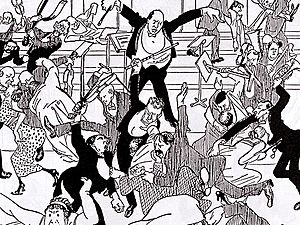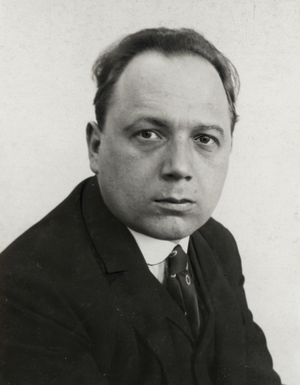Skandalkonzert facts for kids
The Skandalkonzert (which means "scandal concert" in German) was a very famous and chaotic music concert. It was led by the composer Arnold Schoenberg and took place on March 31, 1913. The concert happened in the Great Hall of the Musikverein in Vienna, Austria. It featured music from composers of the Second Viennese School, a group known for their new and sometimes challenging musical styles.
During the concert, the audience became very upset. They were shocked by the music, which was very new and experimental for its time. This style, called expressionism, aimed to show strong emotions. The audience started to riot, and the concert had to stop early. During the chaos, it's said that Erhard Buschbeck, one of the concert organizers, slapped someone in the audience. This event gave the concert another name: Watschenkonzert, which means "slap concert" in Austrian German. A composer named Oscar Straus was there and later said the slap was "the most harmonious sound of the evening."
What Music Was Played?
The concert program included several pieces by different composers:
- Anton Webern: Six Pieces for Orchestra, Op. 6.
- Alexander von Zemlinsky: Four Orchestral Songs on poems by Maeterlinck.
- Arnold Schoenberg: Chamber Symphony No. 1, Op. 9.
- Alban Berg: Two of the Five Orchestral Songs on Picture-Postcard Texts by Peter Altenberg, Op. 4. These songs were seen as very daring, both in their words and music.
The concert ended before the last piece could be played. This was Gustav Mahler's Kindertotenlieder.
The Reaction to Berg's Songs
When Alban Berg's songs were performed, the audience became very loud. They even shouted that the poet, Peter Altenberg, and the composer should be sent away. It was already known that Altenberg was receiving special care at the time. He was not at the concert but had attended a rehearsal earlier. The fighting at the concert began during Berg's songs. The Skandalkonzert had a lasting impact on Berg's work. His songs were not performed again until 1952, many years later.
Why Was There a Scandal?
Just a few weeks before the Skandalkonzert, Schoenberg's Gurrelieder had been performed in the same hall. That concert was a huge success. However, Schoenberg felt that the Viennese audience had not always appreciated his music in the past. So, he refused to accept their applause after the Gurrelieder success. In return, the audience seemed to get their revenge at the next concert of new music.
Newspaper reports from that time describe a lot of noise and fighting. Schoenberg's supporters and his students argued loudly with people who disliked his music. They yelled at each other, threw things, and caused a lot of trouble. Some furniture was even broken.
This famous event happened about two months before another well-known riot in music history. That was the premiere of Igor Stravinsky's The Rite of Spring in Paris on May 29, 1913.



